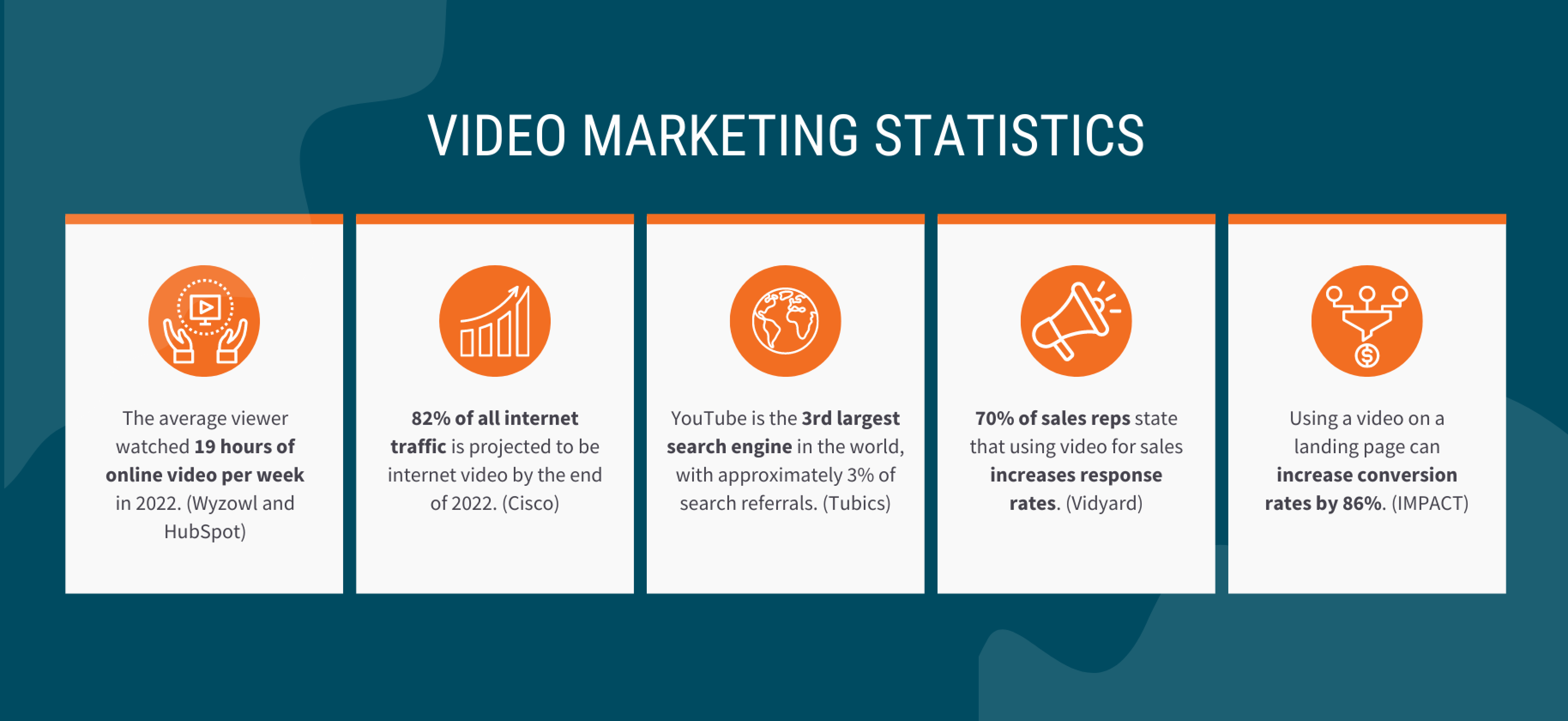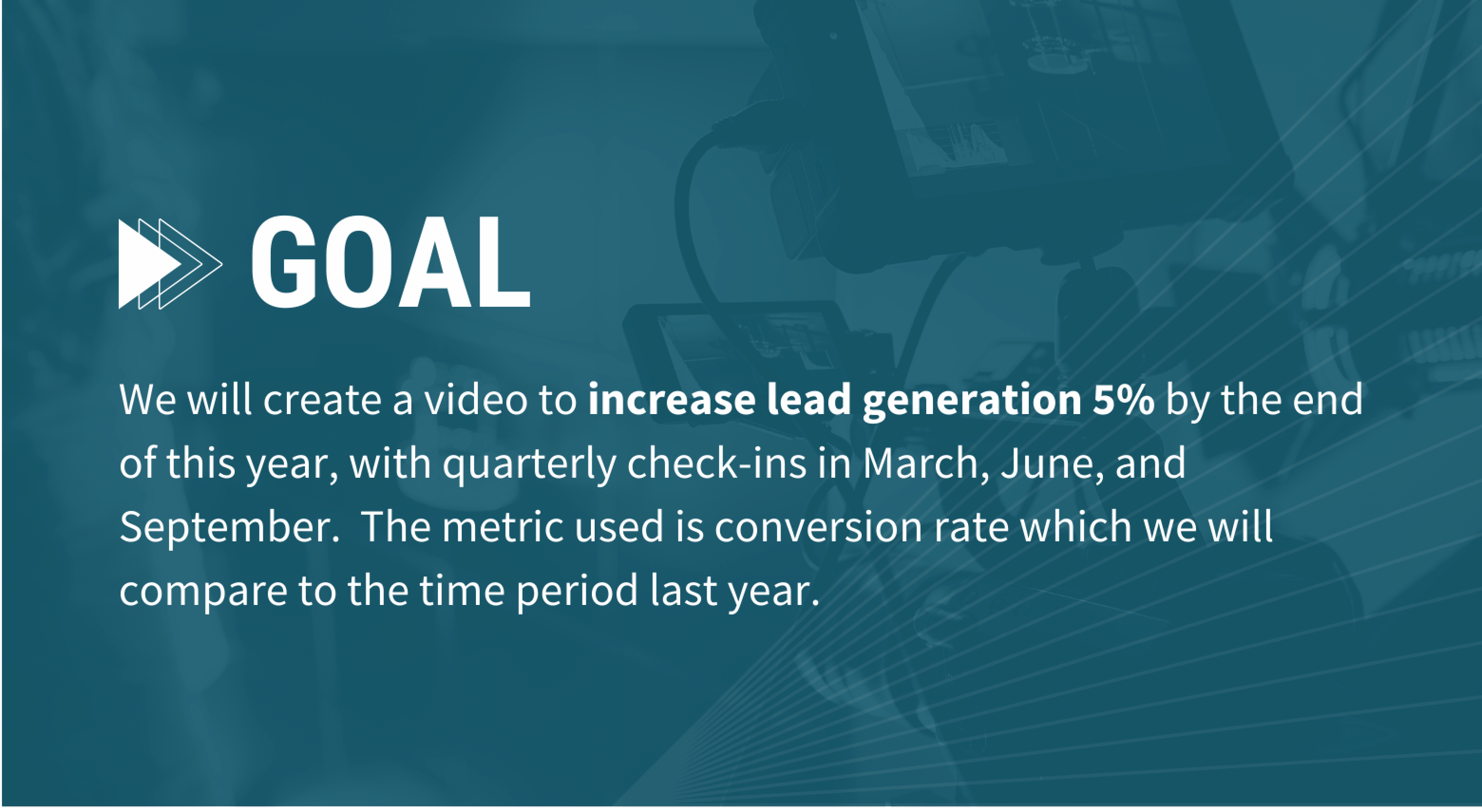Contents
Let me be the first to applaud you. Since you landed here, I assume that you’ve come to realize that it is time to take the plunge into video marketing. Excellent choice! Whether you’re working on marketing efforts for your small business or getting white-labeled video content for many clients, it seems like the time has come to hire a video production company.
At Bridges, while we have plenty of experience working with clients on digital B2B marketing, we also have plenty of what we call “traditional” experience. Many of us on our team spent time at other agencies, working with video production teams as small as two and large as 200.
In our time working with creative teams making quality content, we've gained a lot of experience. So in this blog post, you’ll learn about:
- Statistics on the power of a video marketing strategy
- How to define your goals for hiring video production services
- The questions you need to ask yourself before getting quotes from prospective video production companies
- What to do to hire the perfect company for your end video product
And if you’ve already got a goal of optimizing your video for SEO, then you’re in luck! We have this great free video SEO checklist ready, just for you.
Need to justify the spend? Check out these video marketing statistics.
Video marketing can be time-consuming, cost prohibitive, and risky if you’ve never done it before. No one wants your boss coming to your cube saying, “why did we spend all this money again?”
Furthermore, arguing the case for video marketing is difficult when we discovered in 2020 that Facebook massively over-inflated some of its video viewership metrics by up to 900%. This misinformation caused folks to over-promise the value of video in their digital strategy. Ouch, right in the KPIs.
So while I empathize that there’s a certain amount of distrust towards the outcomes attributed to video marketing, here are some cold hard facts for you:
- The average viewer watched 19 hours of online video per week in 2022. Said another way, that’s two workday’s worth of video (if you worked through your lunch break). (Wyzowl and HubSpot)
- 82% of all internet traffic is projected to be internet video by the end of 2022. (Cisco)
- YouTube is the 3rd largest search engine in the world, with approximately 3% of search referrals. (Tubics)
- 70% of sales reps state that using video for sales increases response rates. (Vidyard)
- Using a video on a landing page can increase conversion rates by 86%. (IMPACT)
I made this infographic for you, too, so you don’t have to make a messy screenshot. Nice huh?

If you find you need more statistics for your slide deck, there are plenty of great articles that round them up. I’m a fan of Vidyard’s Top Video Marketing and Sales Stats that Matter.
So now that you are convinced (or have your boss convinced), great! What’s the next step?
Set goals before hiring a video production agency or company.
Most of the blogs I write or outline discussing improving your digital marketing strategy go back to “set some goals” — and for a good reason. How can you possibly know if you’ve achieved what you set out to…if you don’t know what you were trying to achieve in the first place?
I’ve found that in my time in video production as a producer or creative team member, you won't know when you've hit your objectives if you don’t have a roadmap for your video shoot. That ends up wasting a lot of time and money on an inferior product. So before you start filling out quote tools or posting RFPs, you must make some goals for your video.
For some inside baseball, it’s also a nightmare hearing from a client, “I just need a video.” If that’s the stage of thinking you’re at now, I strongly recommend setting some goals. Save yourself time and money and give your production company the gift of sanity during your shoot.
Step 1: Answer these questions.
We’ll get to specific S.M.A.R.T. goals in a second, but answering the following questions should help you start thinking about your aims for a video before you begin nailing down specific KPIs and timeframes.
1. Do you need a video, or do you just need more content overall?
This is a big moment of truth. How are you faring in other content domains? Do you have a robust blog? Knowledge base? Website and FAQ? If the answer is mostly no, I’d suggest looking at beefing out your other content bases and fixing any SEO mistakes first.
Remember, while YouTube is the 3rd largest search engine in the world, it only accounts for 3% of queried traffic. In contrast, Google and Google Images account for 87% of all queried traffic.
Video marketing is a worthwhile investment of time and money, but make sure you can drive people to take the next step of consuming more content or converting on your site after your video ends.
2. Why do you want a video? What is its purpose?
The why can be broken into four major end-use categories and yield very different proposals.
- Is it for brand awareness on social media or your website?
- Is it to showcase a product or service and spark interest?
- Is it to generate leads?
- Is it to explain something as part of your knowledge base or professional development portal?
As you can imagine, these four options have very different audiences in mind. Once you nail this down, ask yourself the following follow-up questions.
3. Who is the video being addressed to?
This is where having defined customer or buyer personas can be a huge benefit to this brainstorming process. Knowing your target audience helps you create videos that perfectly nail down that target audience’s motivation. An audience that feels spoken to is an audience that is more likely to take the next step, whether that’s just liking or subscribing or filling out a lead capture form.
4. What do you want to happen as an outcome of the video?
That brings us to the last question — what do you want your audience to do after watching your video? This is where you should be as specific as possible. At this stage in the process, we’re not necessarily thinking about realism or attainability.
So while wanting a unique comment for every video view probably won’t happen, don’t cut yourself off from blue sky brainstorming just yet. Our S.M.A.R.T. goals framework will bring us back to reality.
If you get stuck, a trusted partner like a digital marketing agency or another consultant can help you develop your goals.
Step 2: Make S.M.A.R.T. goals.
My favorite goal-setting method is the trusty favorite S.M.A.R.T. Goal. If you’re not familiar, S.M.A.R.T. goal is a goal-setting framework that uses this nifty acronym.
It stands for:
- S: Specific - What do we want to achieve in concrete terms? How many videos do you want to be created?
- M: Measurable - How do we measure achievement? What data do we use to measure it?
- A: Attainable (Or Achievable) - Can you realistically achieve this goal? Is it within scope?
- R: Relevant - Does this goal align with your organization’s values? Does it achieve something that’s needed for your company?
- T: Time-Bound (Or Timely) - Can it be achieved in a realistic timeframe?
After working through the acronym, make a goal statement. That will be one of your sources of truth driving the creative process.
While you don’t need to make a perfect pitch regarding these points, getting the basics worked out will only help you get a more accurate quote and scope of work from any production company you interact with.
(Psst: if optimizing video for search is one of those goals, we’ve got this great SEO video production checklist available to you for free.)
Example of a S.M.A.R.T. Goal for Video Production
For a hypothetical example, let’s say I’m the Marketing Director in the tech industry, setting this goal in January. Here is my broken down S.M.A.R.T. goal process.
- S: Specific - I want to create one video that increases inbound lead generation.
- M: Measurable - Inbound lead generation is measurable through my CRM data. I will utilize my page metrics report to measure total form submissions from a page on my website that hosts my video. I will expect this metric to increase by 5%.
- A: Attainable - To know if 5% is realistic, I’ll look at my historical conversion rate. After considering those, this seems realistic.
- R: Relevant - Lead generation is one of our overarching priorities this year. We also sell a product, so lead generation seems relevant to our organizational aims.
- T: Timely - Considering all our historical data, this is likely an annual goal, with quarterly check-ins.
After working through the S.M.A.R.T. goals statement, here is my final goal statement for this video production project.

Selecting Your Video Production Company
Alright, your goal is set! Now it’s time to shop around for full-service video production companies. Before we go into specifics, let’s review some ground rules for choosing your perfect video contractor.
Good, fast, and cheap?
You’ve probably heard it before, but I want to ensure you fully understand the impact of what’s sometimes known as the iron triangle of project management. Often visualized as a triangle, I think it works even better as a Venn diagram.

The rule is this:
If you want a good and fast product, it won’t be cheap.
If you want a cheap and good product, it won’t be fast.
If you want a cheap and fast product, it won’t be good.
You must keep this rule of thumb in mind as you’re shopping for your video production company. And if I had to make a recommendation, make “good” completely non-negotiable. Decide what it is worth to you to have your video project complete, cost or speed, without sacrificing quality.
After you vet their work for quality, ask your prospective video production company about timeframe and cost. If they can’t get it within the cost you need, you likely need to be more flexible on the timing. If they can’t give you the timing you want, you likely be able to be flexible on the cost.
A B2B Video Production Checklist Just for You
Lost when it comes to SEO for video? Don't sweat it.
We have a helpful checklist offer ready, just for you. Get yours free now.
How to Choose Your Company
After determining your goals, now it’s time to separate out the different methods you could use to pick your perfect video production vendor.
By Skill and Specialty
Different video firms have different skill sets. In the same way that you’re not going to hire an artisan pie maker to cater your steak dinner, you’re not going to ask a company with extensive experience shooting broadcast TV car commercials to make your VR film. Not only are they lacking the expertise required, but would that firm even have the cameras and other equipment to fulfill that request?
So if your goal is to have a specific product as part of your goals, you can shop for your perfect video production firm with different skills or specialties.
Here are some examples of types of videos you might be looking for, but this list is certainly not exhaustive:
- 360-degree or VR videos
- Animated or 3D motion graphic-heavy videos
- Interactive videos
- Drone video
- Time-lapse video
- Corporate videos
- Communication
- Training
- Educational or Explainer videos
- Instructional design
- Commercial videos
- Event videos
- Documentary films
- Social media marketing videos
- Web marketing videos
- Promotional videos
These specialties can also affect pre-production, production, and post-production timing. An animated video that just needs voice-over and editing will have a different production cycle than a video shot on location.
By Scale
How many videos do you want to be created? This goes beyond the iron triangle into questions about scale and scope. The bidding and pre-production process will vary depending on the number of videos you want to be created.
As most production companies want to make their shoot days as productive as possible, if you need five marketing videos shot on a green screen, they’d likely black out their schedule to get them created within the same couple of days.
For video projects that require tens to hundreds of videos, most video production companies will need pieces of pre-production and-post production running concurrently to get them wrapped in a reasonable timeframe. If your prospective company can’t handle concurrent production schedules and you need a lot of videos done, you might want to look elsewhere.
By Industry Expertise
Industry goes outside of skills and specialties. So say you want social media videos, great, but you must consider the subject matter. That shooting process will likely change whether you’re doing B2C casinos or a B2B tech company.
These different sectors typically have a specific cinematic language with unique forms and conventions. While disrupting these expectations can sometimes be effective and attention-grabbing, if it is not done skillfully, it can signal a lack of expertise to the audience — not good!
So ask if your prospective video production agency has more experience shooting B2B or B2C. Then, ask about your specific industry.
Here’s a helpful list you can send your prospective video firm.
|
Examples of B2B Video Expertise |
Examples of B2C Video Expertise |
Either B2B or B2C |
|
Business Services Industries |
Retail and Consumer Product |
Nonprofits, Associations, NGOs, and Churches |
|
Manufacturing Industry |
Restaurants, Bars, and Coffee Shops |
Accounting and Legal Services |
|
Transportation and Logistics |
Large-ticket Consumer Retail |
Hospitality |
|
Energy |
Experience-Driven (Movies, Concerts, Performances, Theaters, Venues, Casinos, Sporting Events) |
Tech and Software |
|
Finance |
Healthcare |
By Location and Shooting on Location
Shooting on location can drastically impact the entire production process. If you’re shooting on location, your pre-production phase will likely be more intensive so that everyone can show up prepared for a productive day of shooting. So one thing that can impact what company you land on is if they have expertise shooting on location or if they excel at controlled shoots on soundstages or back lots.
A direct impact of shooting on location is if the production company in question has experience with shooting where you are headquartered. If you searched for “ video production company near me” or “video production company Oklahoma” through Google, then you might have good odds of finding a company that understands the challenges of creating a video where your organization is. However, if that search query runs dry, you might need to widen your search.
Here are some things to ask the company whether they’re a crew flown in from Los Angeles or already on your home turf:
- Are you bringing gear appropriate for my weather (if shooting outside)?
- If we’re shooting at a property I don’t own/manage, do you have the appropriate permits to shoot, or will I need to get them?
- Will you scout the location thoroughly before production day?
- Looking for lights, sound, safety, and access to electricity.
That’s a wrap!
So you’ve determined your overarching video production goals and KPIs and built your S.M.A.R.T. goal statement. Great! After working through the above list of selection criteria, you likely have a shortlist of vendors. Or, if you’re still plain stuck, you can always reach out to us — we’ll give you our recommendations for our trusted partners at no charge to you.
And if you need help taking the video from posted to optimized, pick up our free video SEO checklist to take the guesswork out of making a splash with the video project you’re planning.

Alexandra Bohannon, MPA
Alexandra Bohannon is the Director of Content & Creative at BridgeRev. She has a Master’s degree in Public Administration (Public Policy) and a Bachelor’s degree in English Literature — the perfect blend of data science and wordsmithing. Her passions include writing, researching, and helping people get the results they want.





